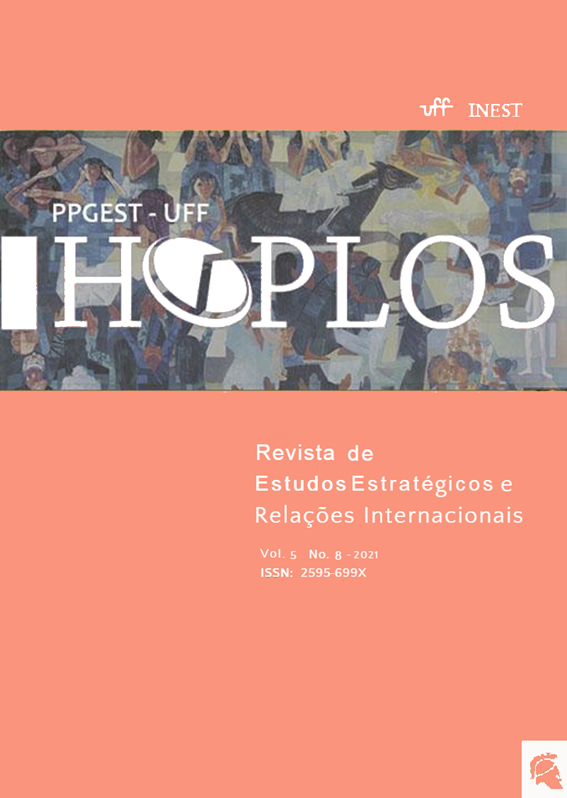FINANCIAL WARFARE, ECONOMIC SANCTIONS AND EURASIAN GEOPOLITICS
Keywords:
United States, Iran, Financial Warfare, Eurasian GeopoliticsAbstract
The United States has been using commercial and financial tools to put pressure on the Islamic Republic of Iran since the outbreak of the Islamic Revolution in 1979. These constraints have their objectives associated with geopolitical dynamics and not with the economic field. The main hypothesis of the article is that trade sanctions and the financial attack fulfill the function of constantly pressure on an opponent of the United States located in a strategic region. To explore the main hypothesis, the article will present a brief history of the commercial and financial pressure applied by the United States against Iran. In addition, to anchor economic pressure in the logic of geopolitics, the article will also introduce the teachings of three thinkers in an introductory way, Halford Mackinder, Nicholas J. Spykman and Zbigniew Brzezinski. Such authors contribute in a fundamental way to understand the importance of the space where Iran is for the geostrategy of the United States
Downloads
References
Referências
BANDEIRA, L. A. M. A desordem mundial: o espectro da total dominação. Civilização Brasileira: Rio de Janeiro. 2016.
BRZEZINSKI, Z. Game plan. Atlantic Monthly Press, 1986.
BRZEZINSKI, Z. The grand chessboard: American primacy and its geostrategic imperatives. New York: Basic Books, 1997.
BRZEZINSKI, Z. Strategic vision: america and the crisis of global power. New York: Basic Books, 2012.
COSTA, W. M. Geografia política e geopolítica: um discurso sobre o território e o poder. São Paulo: Editora Universidade de São Paulo, 1992.
DREZNER, D.W. Sanctions sometimes smart: targeted sanctions in theory and practice. International Studies Review Volume 13, 96–108. 2011. Disponível em: <https://academic.oup.com/isr/article-abstract/13/1/96/1807429>. Acesso em: 27 ago 2020.
DUBOWITZ, M.; FIXLER, A. Cyber-enabled ‘swift’ warfare: power, blowback, and hardening american defenses. In: S. F. Ravich, Cyber-enabled economic warfare: an evolving challenge. Washington: Gudson Institute, p. 14-48. 2015.
EUA; Departamento de Estado. Designation of iranian entities and individuals for proliferation activities and support for terrorism, 2007. Disponível em: <https://2001-2009.state.gov/r/pa/prs/ps/2007/oct/94193.htm>. Acesso em: 11 out 2020.
FAYAZMANESH, S. The United States and Iran: sanctions, wars and the policy of dual containment. Nova Iorque: Routledge, 2008.
FENAROLI, G. C. Financial warfare: money as an instrument of conflict and tension in the international arena. Senior Projects Spring 2016. Disponível em: <https://digitalcommons.bard.edu/senproj_s2016/136/>. Acesso em: 18 ago 2020.
GERACE, M. P. Between mackinder and spykman: geopolitics, containment, and after, in “Comparative Strategy”, vol 10, p. 347-364, 1991.
KATZENSTEIN, S. Dollar unilateralism: the new frontline of national security. Indiana Law Journal, 293 – 351, 2015. Disponível em: <http://ilj.law.indiana.edu/articles/16-Katzenstein.pdf>. Acesso em: 15 ago 2020
KATZMAN, K. Iran sanctions. Washington: Congressional Research Service, Julho, 2020.
KITTRIE, O. F. New sanctions for a new century: treasury's innovative use of financial sanctions. University of Pennsylvania Journal of International Economic Law, 189-822, 2009. Disponível em: <https://scholarship.law.upenn.edu/jil/vol30/iss3/3/>. Acesso em: 23 ago 2020.
LACOSTE, Y. A geografia: isso serve, em primeiro lugar, para fazer a guerra. Campinas: Papirus. 1988.
MACKINDER, H. Geographical pivot of history. The Geographical Journal,, Vol. 23, No. 4, p.421-444, 1904.
MALONEY, S. Iran's political economy since revolution. Washington, DC: Brookings Institution, 2015.
MELLO, L. I. Quem tem medo da geopolitica? São Paulo: EDUSP, 1999.
PADULA, R. O pensamento geoestratégico e os documentos estratégicos dos EUA no pós Guerra Fria. Carta Internacional (USP), v. 13, p. 31-55, 2018.
PECEQUILO, C. S., & FORNER, C. N. Barack Obama e o Oriente Médio: um Panorama Crítico (2009/2017). Carta Internacional, v. 12, p. 101-125, 2017.
RAJENDRAN, G. Financial blockades: reserve currencies as instruments of coercion. In: A. Wheatley, The power of currencies and the currencies of power, pp. 87-101. London: Routlegde. 2013.
RIVLIN, P. Leverage of economic sanctions - the case of US sanctions against Iran, 1979–2016. In: M. WIGELL, S. SCHOLVIN, & M. AALTOLA, Geo-economics and power politics in the 21st century: the revival of economic statecraft, p. 135 - 153. New York, NY: Routledge, 2018.
SERRANO, F., & MEDEIROS, C. A. Padrões monetários internacionais e crescimento. In: J. L. FIORI, Estados e moedas no desenvolvimento das nações, p. 119-151. Petrópolis: Vozes, 1999.
SILVA AZEVEDO, F. Sanções financeiras: um estudo de caso sobre o uso da arma monetária sobre o Irã. Rio de Janeiro: UFRJ [Dissertação de mestrado], 2020. Disponível em: <https://www.ie.ufrj.br/images/IE/PEPI/disserta%C3%A7%C3%B5es/2020/Disserta%C3%A7%C3%A3o%20Fernando%20Silva%20Azevedo%20-%20PEPI.pdf>. Acesso em: 04 set 2020.
SPYKMAN, N. Geography and foreign policy I. The American Political Science Review, Vol. 32, No. 1, p. 28-50, 1938.
SPYKMAN, N. America's strategy in world politics: the united States and the balance of power. Nova Iorque: Harcourt, Brace and Company, 1942.
TORRES FILHO, E. A bomba dólar: paz, moeda e coerção. Instituto de Economia - UFRJ - Texto para Discussão 026 | 2019. Disponível em: <https://www.ie.ufrj.br/images/IE/TDS/2019/TD_IE_026_2019_TORRES%20FILHO.pdf>. Acesso em: 01 ago 2020.
WILKINSON, D. Spykman and geopolitics. In C.E Zoppo e C. Zorgbibe (editores) On Geopolitics: Classical and Nuclear. Dordrecht:Martinus Nijhoq, 1985.
XIANGSUI, W., & LIANG, Q. Unrestricted Warfare. Beijing: PLA Literature and Arts, 1999.
ZARATE, J. Treasury’s war: the unleashing of a new era of financial warfare. New York: PublicAffairs, 2013.
Downloads
Published
How to Cite
Issue
Section
License
Copyright (c) 2021 Fernando Silva Azevedo

This work is licensed under a Creative Commons Attribution-NonCommercial-ShareAlike 4.0 International License.
1. PROPOSTA DE POLÍTICA PARA PERIÓDICOS DE ACESSO LIVRE
Autores que publicam nesta revista concordam com os seguintes termos:
a. Autores mantém os direitos autorais e concedem à revista o direito de primeira publicação, com o trabalho simultaneamente licenciado sob a Licença Internacional Creative Commons Attribution - Share Alike 4.0 que permite o compartilhamento do trabalho com reconhecimento da autoria e publicação inicial nesta revista.
b. Autores têm autorização para assumir contratos adicionais separadamente, para distribuição não-exclusiva da versão do trabalho publicada nesta revista (ex.: publicar em repositório institucional ou como capítulo de livro), com reconhecimento de autoria e publicação inicial nesta revista.
c. Autores têm permissão e são estimulados a publicar e distribuir seu trabalho online (ex.: em repositórios institucionais ou na sua página pessoal) a qualquer ponto antes ou durante o processo editorial, já que isso pode gerar alterações produtivas, bem como aumentar o impacto e a citação do trabalho publicado (Veja O Efeito do Acesso Livre).








